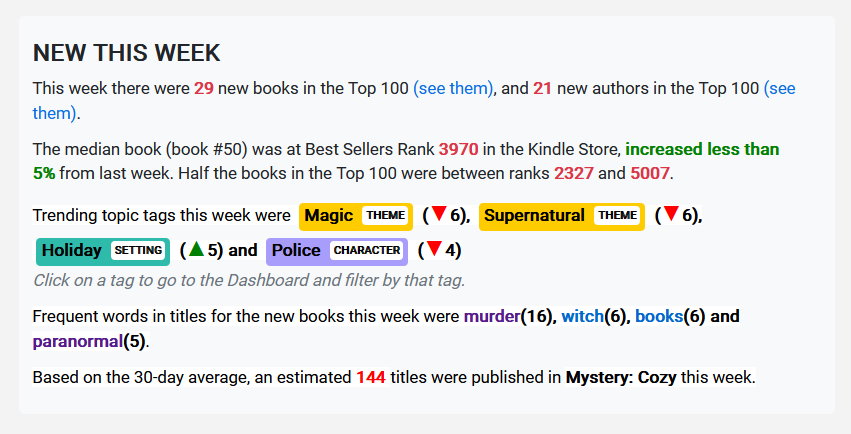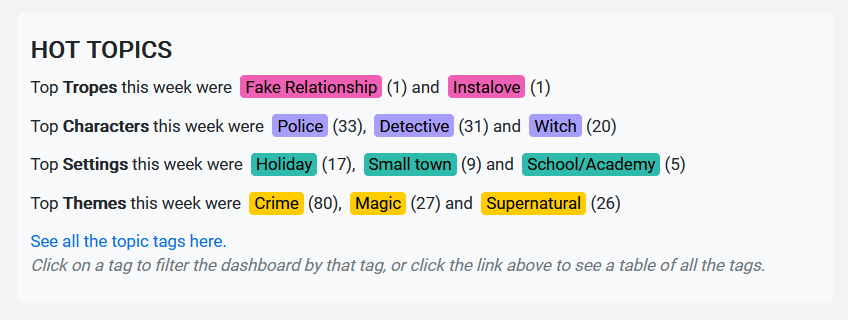Introduction
There’s a lot of information in a Kindletrends newsletter, and when you first get one it might be hard to know where to start. Here are some of the most common things you might want to do if you’re an author, and how you can use the information in Kindletrends to help.
First, if you haven’t already seen it, work through the interactive tour:
Take a tour of a Kindletrends newsletter
Next, get a recent newsletter and try some of these:
How to start researching a genre
To get a general picture of what a genre is like, start with the ‘New This Week’ section:

Although the median Best Sellers Rank is important, it’s not the only important thing about a genre. The gap of ranks for ‘half the books’ will tell you if the genre is dominated by a few books which are very popular, or whether there’s a consistent spread of high-ranking books.
Don’t be put off if the median book isn’t a high rank, though; many authors are successful even in less-popular genres, because they understand what readers want, and keep producing quality work.
Next, get an idea of what type of books are common in the genre by going to the Hot Topics section:

Click on the topic tags to go to the detail of books with that tag: so, click on the link that says ‘magic’ to go to all the books in the Top 100 with ‘magic’ as a story element. Once you’ve done this a few times and looked at the books, you’ll get an idea of what themes are common in the genre right now.
Next, look at the Sales Rank Distribution plot:

Although there’s a lot of information here, it’s not as complicated as it looks. Each dot represents a book in the Top 100, and the colors show whether the book is new (<30 days) or older. Some genres are dominated by new books, and have a lot of churn; they’ll show up as having a lot of red dots toward the left-hand side of the plot. Other genres have more ‘evergreen’ books; they’ll have more green and blue dots spread out across the whole range of sales ranks.
Click the links below the Sales Rank Distribution plot to look at the books which are new, and compare them to older books. Are they both the same, or can you see differences in style? For the older books, are they still in the Top 100 because they’re by a famous author? Or are they part of a big series? Recognizing differences in different styles of books will help you decide what to do with your own work.
Finally, click the ‘Open the Dashboard‘ button to get a spreadsheet of all the books in the Top 100 – titles and subtitles, price, page numbers, ranks and publisher details. Using this detailed information, you can choose which books to look at more closely. Try finding an author or a series that you think is successful, and matches the style of books you think you could write; read them closely, and look at comments from Amazon reviewers to find out what it is that readers like about those books.
How to spot trends in covers and titles
Cover design is always challenging, but you can quickly get a picture of what’s popular in a genre by looking at the cover montage:

Similar covers are grouped together, so you can see trends in cover types, even when one style is used across a number of different color tones (like in a series). Choose a few covers in different styles, and think about what those covers say to readers about the content of the book – can you see specific things about the tropes in a book implied by the cover?
Next, look at the list of frequent words in titles and subtitles. Sometimes it’s not just the most frequent words which tell us about what’s trending; if you scan down the list and click on a few words, you might see a bunch of other words which go together, or which indicate tropes.
In a lot of genre fiction, authors use the title and subtitle to clearly signal tropes to readers: along with the cover, the title and subtitle are their way of saying ‘if you buy this book, this is what you will get’. Read through a few newsletters for a few weeks, and you’ll start to see common patterns in what’s being shown to readers.
How to write better blurbs
If the cover and title entice readers to click on your book in an ad, a newsletter, or from a search result, then the blurb is what convinces them to make a final buying decision. Blurb writing is a real skill, and there are lots of books about it – but a good place to start is by dissecting the structure of popular blurbs in a genre.
To begin, have a look at the ‘word cloud’:

This is created from all the words, in all the blurbs in the Top 100. The bigger a word is, the more frequent it is in blurbs. Like the titles and subtitles, this tells you what authors think is most important to signal to readers; it might be human relationships, or it might be adjectives about the story, or it might be nouns describing the setting.
If you want to look more closely at these, you can look at books featuring the top words, or the whole list of all the words along with their frequencies; there are links for both of these in the newsletter, to the Kindle Store.
Next, look at how long the blurbs are and how many are in first-person or third-person styles. Some genres are almost exclusively one or the other, and some are surprisingly close to 50/50. Neither is right or wrong, and there’s no rule that says your blurb must match your book, but you might find that your style of writing suits one or the other more easily. If you can, try writing your blurb in a couple of different styles; this makes you think about what in your story is really going to appeal to readers.
Finally, look at the blurbs themselves: I’ve collected them all together for you in a PDF file, so you can skim them quickly, and pick out the ones that appeal to you. Click on the Blurbs button in the Downloads section to save them to your computer, and work through them one by one. Try and think like a reader of your work, and note down the ones that would make your reader want to buy the book.
When you’ve read through them, go back to the ones you’ve noted, and try to write your own blurb in that style. This can be challenging, but this way you’ll quickly find what works for you and what doesn’t.
Does this look useful? Subscribers get this updated every week for 14 different fiction categories, plus monthly newsletters diving deeper into trends.

